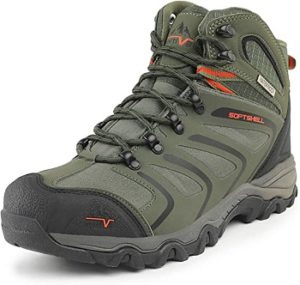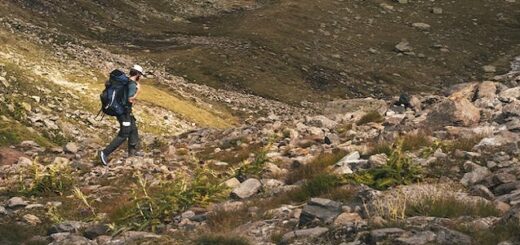Top 4 Best Hiking Boots for Overpronation
by Ryan W ·
This page may contain affiliate links. For more information, see our "About Us" page.
Top 4 Best Overpronation Hiking Boots

Getting out and about in nature is all fun and games until one struggles with injuries. Proper mechanics are crucial in aiding the body at working as efficiently as possible. But what happens when a flawed body mechanic isn’t your fault? There are a number of problems and conditions that can affect the foot and ankle region. These “mechanical malfunctions” can be triggers that end up causing even more issues the longer one deals with them. Today we’re diving into overpronation, as well as some of the best hiking boots to support the condition.
What is Overpronation of the Foot?
To explain overpronation, one must have a solid understanding of what pronation is in the first place. Simply put, pronation is the intended natural motion or movement of your foot and the amount of inward roll produced. The proper inward roll varies from person to person based on factors such as flexibility as well as the height of their foot arches.
Overpronation, on the other hand, is when inward rolling motion is more exaggerated than it should be. In other words, the outside edge of your heel strikes the ground first, and then the rest of the foot follows inwards and onto the arch. After a while, overpronation winds up causing a flattening of the arch, resulting in a strain being placed upon your ligaments, muscles, and even tendons. Eventually, people that overpronate are likely to experience injuries such as heel spurs, ankle sprains, tendinitis of the Achilles, and even plantar fasciitis.
What is Tendinitis?
Tendinitis might sound like an imposing word, but it isn’t a difficult concept to grasp. In short, tendinitis is an inflammation of a tendon, which are “cords” that attach muscles to your bones. You may have heard of things such as Jumper’s Knee or Tennis Elbow, which are both types of tendinitis, named after the specific body part affected. The same goes for Achilles tendonitis, named after the tendon which connects the gastrocnemius (calf muscle) and soleus muscle to the heel bone.
Common signs that you may be dealing with tendinitis can include things such as mild swelling, tenderness, and a dull, achy pain that flares up when moving the affected area. Less severe cases of tendinitis tend to resolve on their own given sufficient rest.

What is Plantar Fasciitis?
Moving on from tendinitis, plantar fasciitis is another beast entirely. Traveling the length of the bottom of the foot, there is a tissue band called the plantar fascia which connects the toes to the heel bone. In the grand scheme of things, you could look at plantar fasciitis being quite similar to tendinitis in that both are caused by inflammation. The major difference being that the plantar fascia is a ligament and not a tendon. One of the most frequent complaints from those suffering with plantar fasciitis is a sharp, stabbing pain originating from the heel region.
Some of the more common risk factors for developing plantar fasciitis include foot mechanics (over or underpronation), obesity, and age, as this problem is more prevalent in those between 40 and 60. Further complications can occur as some people try to alleviate the pain by placing their weight primarily on the front of their foot, which overtime can actually result in Achilles tendonitis. This can be a vicious cycle to say the least. For information regarding diagnosis and proper treatment of plantar fasciitis, head over and check out this article at Mayoclinic.org.
Underpronation vs Overpronation
Underpronation, also known as supination, is (unsurprisingly) the opposite of overpronation. If you’re suffering from supination, the ankle doesn’t roll inwards enough for proper pronation, resulting in an outward roll of the foot. This puts an undue amount of stress on the toes and ankle region. Underpronation is common in people with high arches as well as tight Achilles tendons. Not wearing proper support for high arches also tends to exacerbate the problem.
Usual telltale signs of underpronation include pain throughout the arch, as well as the ball of the foot. Like overpronation, supination can result in complications such as heel spurs, sprained or rolled ankles, plantar fasciitis, as well as bunions and hammertoes.
How to Correct Overpronation
Correcting overpronation can be quite the journey. First and foremost, one should be certain to choose supportive footwear, featuring added stability to reduce step impact. The second step usually consists of the implementation of orthotics, or special inserts that lend to added arch support to aid in the way a person walks. Finally, sometimes physical therapy will be required if the amount of overpronation can’t be compensated for. They will guide the person through stretches and exercises that support the foot arch and the surrounding muscles.
On the other hand, there are times that overpronation is the result of habit and not a physical ailment. Simply being mindful of the way your feet hit the ground can often be enough for those with mild overpronation. Be aware, however, that retraining your motor pattern will take time. After all, you’ve been walking that way (most likely) for your entire life.
Top 4 Best Hiking Boots for Overpronation
It should be noted that hiking boots aren’t commonly designed with pronation difficulties in mind. Boots with solid ankle and arch support should be paired with inserts for the ultimate combination. The options listed below are based upon these two factors.
1. NORTIV 8 Ankle High Waterproof Hiking Boots
Coming in at number one on our list we have the NORTIV 8 Ankle High Waterproof Hiking Boots. Finding solid options with high ankle support while maintaining comfort is a difficult task when it comes to hiking footwear. A rubber toe cap and reinforced heel combine to strengthen overall stability all while providing more ankle protection. The NORTIV 8’s also feature a removable yet flexible insole that provides proper arch support to aid my fellow overpronating hikers. Finally, their rubber sole helps prevent slips on rough terrain, allowing peace of mind when it comes to potential twisted ankles. All in all, we feel that the NORTIV 8 are the most well-rounded choice for overpronation, and their price isn’t too bad either!
2. Merrell Moab 2 Vent Mid Hiking Boots
Next up, we have the ever popular Merrell Moab 2 Vent Mid Hiking Boots. Comprised of 100% suede leather and mesh, these mid height boots have a 5mm lug depth, providing an unparalleled amount of traction. Their air cushioned heel, nylon molded arch shank, and removable insole supply ample amounts of comfort and stability. A light, breathable mesh rounds out the construction, allowing proper airflow to keep your feet dry even in the hottest of temperatures. Not to mention they’re available in six different color combinations! Merrell also boasts about their usage of recycled materials, which is a huge plus in my book! Any company that legitimately cares about our planet has my full support.
3. Salomon X Ultra 3 Mid GTX Hiking Boots
Moving on, Salomon finds their way onto our list at number three with their X Ultra 3 Mid GTX Hiking Boots. Providing strong ankle support, these boots come in at 448 grams, making them fairly lightweight for a mid height boot. Gore-tex waterproofing ensures dry socks even in the wettest of conditions, while their patented “EnergyCell” high performance foam midsole absorbs the majority of the shock you’ll encounter during your hikes. Another point to note is that Salomon has been in the outdoor sports gear space since 1947, so you know they make quality products. This is definitely a top end boot for your backpacking and hiking needs.
4. NORTIV 8 Mid Waterproof Hiking Boots
Rounding out our list of the top 4 best hiking boots for overpronation, NORTIV once again makes their presence known, this time with their NORTIV 8 Mid Waterproof Hiking Boots. Following close behind their ankle high counterparts, these mid options provide a 3 layer construction for incredible comfort. First, the rubber outsole lends to a superior grip, then the EVA midsole aids in absorbing impact to help reduce strain. Finally, the memory foam insert supports your arch to the fullest – a must for under AND overpronation. As with their ankle high option, NORTIV again knocks it out of the park with the price to performance ratio. If money is tight, definitely consider giving them a look for your hiking boot needs.
Best Hiking Boots for Overpronation – Conclusion
Hopefully this article has provided a fair amount of insight into some of the more common foot and ankle related mechanical issues. Overpronation isn’t to be taken lightly, and wearing the best possible pair of hiking boots can be a godsend when it comes to relief. Please be aware that this article shouldn’t be taken as a medical diagnosis. If you are uncertain as to whether you suffer from over or underpronation, please see a professional! Not all foot pain or discomfort is created equal. If you’re looking for more hiking-related content, consider checking out our article “6 of the Best Red River Gorge Waterfall Trails”. Safe trips and happy travels!







